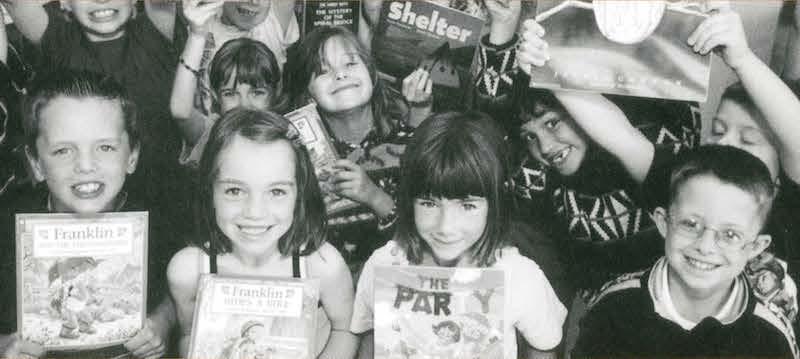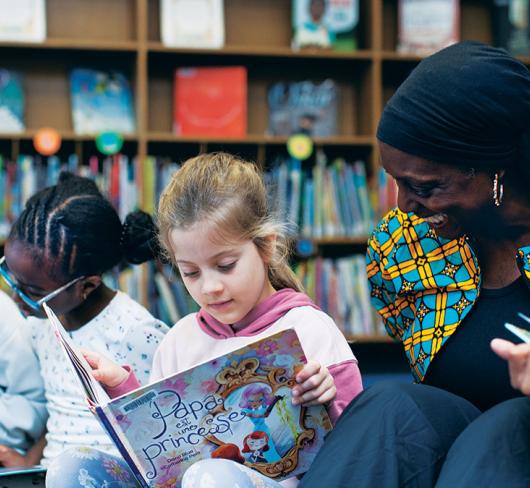
The Class that Reads: Best Practices for Primary Reading
This curriculum insert offers a preview into the soon-to-be-released ETFO primary reading resource called The Class That Reads is written by Etta Kaner, Cathy Miller-Davis, Judith Taylor and Jan Moxey. Connected closely to current curriculum expectations, this resource is a primary teacher’s "best practice guide” to the teaching of reading.
Developed as a result of a reading survey conducted by ETFO, The Class That Reads offers practical information, management ideas and support for the learner in all areas of the reading program. A reading wheel that displays the components of the reading program and the fundamental factors that affect reading in a primary classroom create a focus for the publication. A planner and parent booklet are also key features of this soon-to-be-released and not - to-be - missed resource.
This Voice insert provides a glimpse of one of the reading components from the reading wheel, Independent Reading. Watch your steward's mailings or check the ETFO website at www.etfo.on.ca. for ways to order your copy of this outstanding document.
Independent Reading
How to do independent reading
Provide a range of materials, both fiction and non-fiction, for students to read.
Look for:
- Books that have been used previously in read aloud, shared or guided reading sessions.
- High quality well written texts that students can read independently.
- Books that have powerful illustrations and interesting, provocative text that will interest students.
- A variety of text forms: poetry, concept books, folk tales, fairy tales, picture books, nursery rhymes, pattern books, chants, literature from adventures to classics.
- Real world reading can be introduced through environmental print, newspapers, recipes, maps, brochures and children’s magazines.
Establish a Silent Reading Time
During initial independent reading sessions, the teacher demonstrates how to select books and how to read independently.
Some points to remember:
- Allow students time to read the material and get involved with the text.
- Sometimes silent reading is assigned 15-20 minutes at the same time each day. This is referred to as dear - Drop Everything and Read, or ussr - Uninterrupted Sustained Silent Reading.
- Once routines are established some of the time could be used by the teacher to have reading conferences and to monitor student selection
- of materials.
- Students read their selected materials and record on a reading record form, such as the one accompanying this article. The form uses a colour guide so students can indicate the kind of materials they are reading.
Management of independent reading
Much of the success of the silent reading time will depend on how well the environment and the class is prepared. Here are some things to get ready before you start that will help ensure success.
- Display books with covers showing in order to assist students in finding books of interest.
- Display recent read-alouds, guided and shared reading books in the same place and easily accessible.
- Monitor student involvement and touch base with the students who require some assistance to locate what they want to read.
- Have interesting book displays or bins displayed by topic.
- Set up reading records where books will be recorded. A sample reading record is included here.
- Set up an author study area to display books from a variety of authors.Create a climate of support as students extend their efforts by selecting challenging reading materials.
- Have different kinds of books available.
Managing Student Movement and Involvement
Managing student movement as the children choose books to read is of vital importance, as is keeping each child involved in the activity.
- Keep book displays in different places in the room so students don't push or crowd in order to select books.
- Set a routine for selection early in the year so students realize they will not have unlimited time to find their selection.
- Set a predictable routine, such as the time of day, location of reading materials and storage of reading records to red uce the movement around the room.
- Allow students to find selections by table group, sock colour or birth months. This can reduce the frenzy of finding books.
- Have students select several books to keep with them to read. This will avoid needless wandering and exchanging books.
- Provide time for recording books that have been read.
Individual students may need assistance to maintain attention to the task of independent reading. The teacher may need to intervene with individual students to ensure their time is being used productively.
Strategies that can assist some students include:
- Having students generate questions that might be answered from reading.
- Leading students in predicting before they read.
- Monitoring task commitment and intervene as necessary.
- Nodding or make eye contact to help some students keep on task.
Making a Productive Reading Environment
Independent silent reading in the early primary classroom is rarely 'quiet.’ Depending on the reading stage, many of the students will read aloud or under their breath as they read independently. While allowing a range of reading behaviours it is important to encourage an atmosphere that will allow students to read and focus on their reading.
Any noise should be related to the task of reading. If you are reading or having an individual student conference, sit in a location where you can see with the whole class and monitor their behaviour.
Finding Time for Independent Reading
Time for independent reading should not be considered a frill, but an essential component of an effective reading program. Scheduling time for independent reading should be a high priority.
Provide Support to the Learner
Honour all readers and their level of independent reading. Prevent and quickly squash any negative comments about anyone’s reading level.
Some ideas for providing additional support for learners:
- Non-readers can participate in independent reading time by reading wordless books or 'pretend' reading.
- A listening centre set up with recordings of recent read alouds, guided or shared reading materials can be used by students who require that kind of help.
- Books that can be read on the computer are also useful for students to read during independent reading time as they provide reading support to students who may need it.
- Provide encouragement as students try demanding new material. If the material is too difficult, let students know that it is all right and they can try that book again later in the year. This is one of the amazing things for students, as they see themselves becoming readers.
Springboards
Link books that have been read aloud, shared and guided reading materials to the independent reading process whenever possible.
- Publish and display students’ choices from independent reading records.
- Encourage students to read part of an independent reading selection when given an opportunity to read aloud to their classmates.
- Have students record the titles of their favourite books read during independent reading time on strips of colourful paper and decorate the room with their recommendations.
- Work with the teacher librarian to display favourite titles in the library under such headings as: ‘Number One with Grade One’ or ‘Tops with the Twos' and Terrific Titles from the Threes.'
- Independent reading does not always have to occur during school hours. Reading clubs and home reading programs can engage students in independent reading at other times. A Recess Readers Club is a popular activity at some schools. Bookmark samples and certificates for the Recess Readers Club are included here.
Independent Reading - Reading that Builds
- Builds vocabulary
- Builds fluency
- Builds background
Recommended Resources
Booth, David, Larry Swartz, Megudio Zoia. Choosing Childrens Books. Annotated list of 600 best books selected by Canadians. Pembroke Publishers, Toronto. 1987.
Routeman, Regie, Invitations: Changing as Teachers and Learners K-12. Heinemann. 1994.

